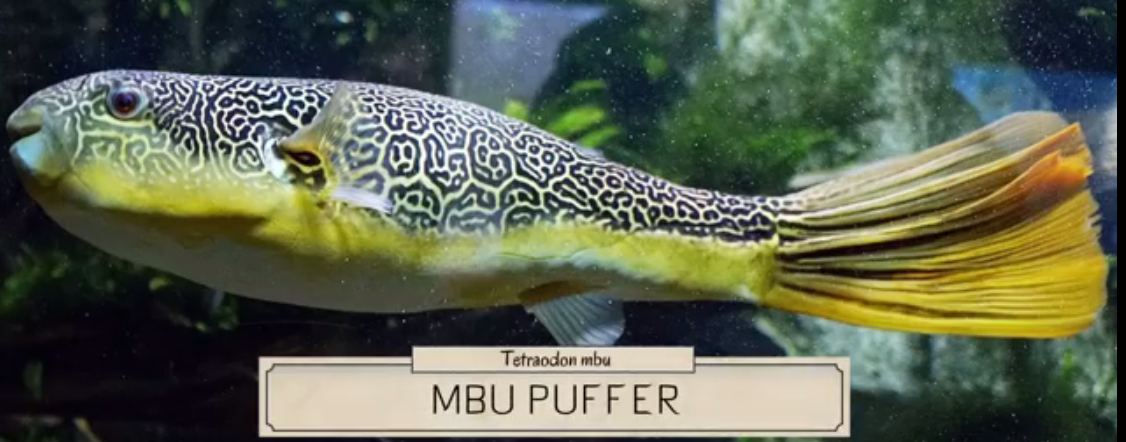There are over 150 species of pufferfish in the world, and it is only about 30 species that can are truly freshwater.
Pufferfish are stocky and chubby looking in appearance, and they have four large teeth that are fused on their jaw.
Pufferfish are also known as blowfish because of their ability to inflate their body when threatened. They do not have scales while their skin is covered with spikes.
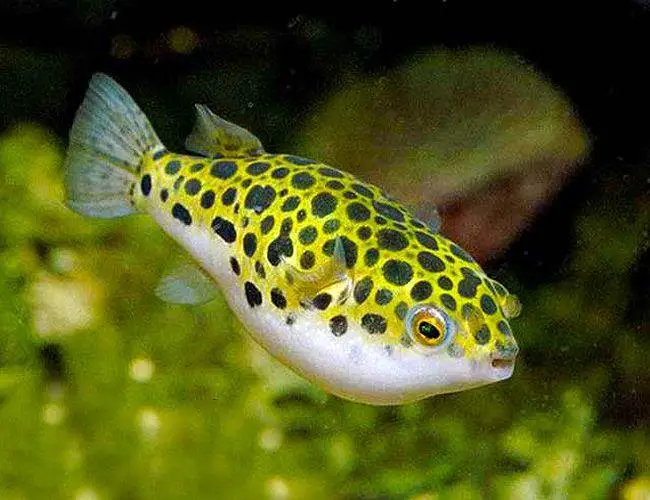
You are going to find freshwater puffers in river systems throughout Southeast Asia, some parts in Bangladesh and India, the Congo, Nile, other rivers in Africa, and the Amazon basin in South America.
Pufferfish are getting more popular in the aquarium hobby because they are intelligent and fun to keep.
There is not enough information about them, and some people still confuse which species belongs to freshwater and those that will do well in brackish aquariums.
I had to do extensive research and come up with this article about the age and growth of freshwater pufferfish.
Freshwater pufferfish vary significantly in shape, color, and size as they range from 1 inch to more than 24 inches in size.
Some of the common freshwater pufferfish are dwarf puffer, crested puffer, Congo puffer, Mbu puffer, imitator puffer, South American puffer, Fahaka puffer, and so on.
Contents
Size of freshwater puffers according to their age
Pufferfish come in varying in size from the dwarf puffers that can grow to 1 inch to giant freshwater puffers, which can grow to over 2 feet in length. The size of puffers as they grow up are listed below.
10-days pufferfish
Most pufferfish go through the same process of fertilization.
After the eggs are laid, there is usually no parental care.
The fry goes through the planktonic phase before they then develop into real fish.
During the first 10-days, most freshwater puffers are in the planktonic stage, and they are about 3mm in size. They feed on their yolk sac and then on newly hatched brine shrimp.
Juvenile pufferfish
During the juvenile stage, you can start to differentiate each species of pufferfish by their size. Dwarf pufferfish can grow to about 7-8mm during the juvenile period.
Red-bellied puffer and South American pufferfish can grow to about 1-2 inches. Juvenile Mbu pufferfish can grow to about 8 inches in size.
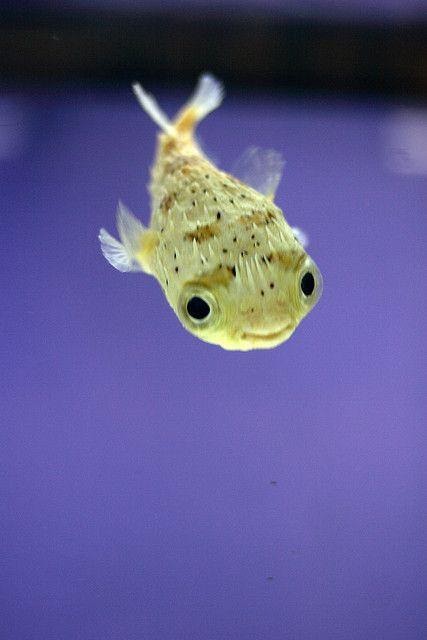
Baby puffer
Adult pufferfish
Dwarf pufferfish can go to a maximum height of about 1-2 inches.
Adult red belied puffer and South American pufferfish can grow to a maximum size of about 8cm (3.1 inches).
While Mbu Puffer is the largest freshwater puffer, and they can grow to about 24-30 inches when they reach full maturity.
Color of freshwater puffers
Dwarf pufferfish
During the juvenile stage, both male and female dwarf puffers are identical, they are golden brown with metallic reddish-brown speckles and blotches appearance.
During maturity, the males are different from the female. The female has golden brown with metallic reddish-brown speckles coloration.
The mature male has a dark band that runs along the belly of the fish.
The blotches on their flank are also more prominent, which is arranged in longitudinal bands.
The males are usually smaller, and they have a dark line that runs down their white belly. The females are generally more rounded, and they may or may not show smallish spots between their more extensive dark markings.
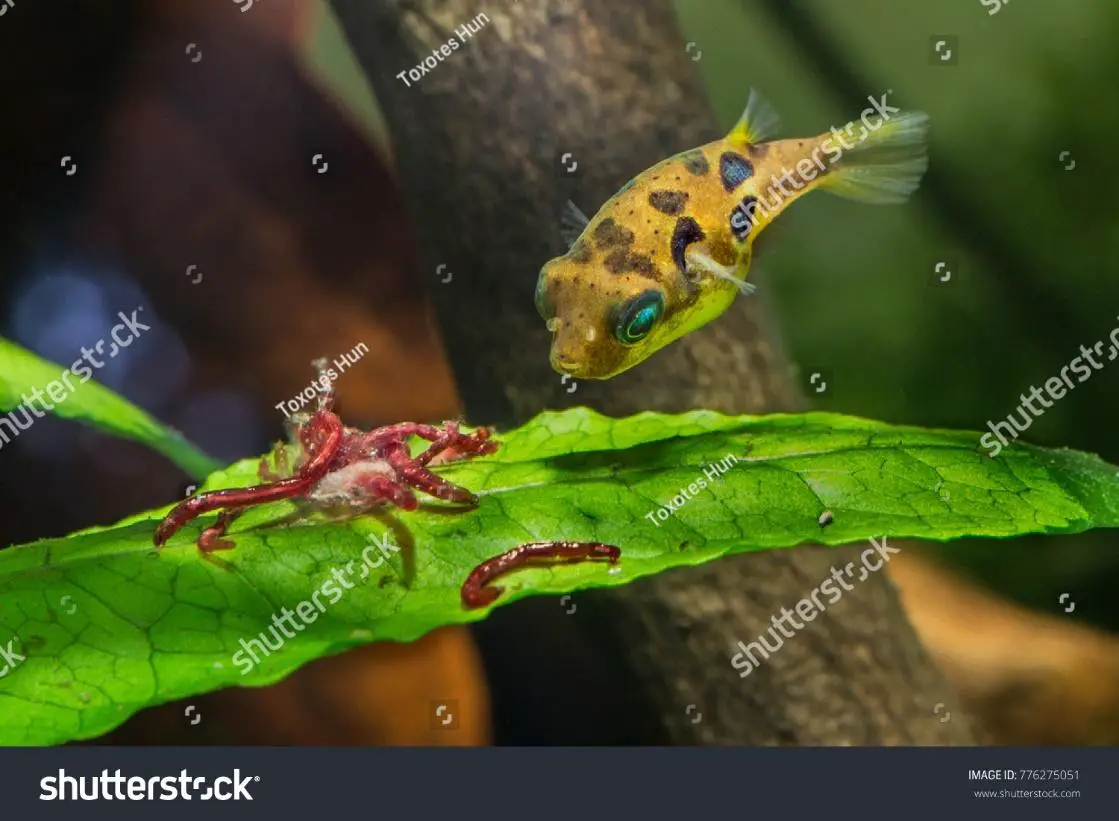
South American Puffer
The South American Puffer looks similar to other puffer species when they are at the juvenile stage.
They have white bellies with yellow to green back with a different pattern.
During maturity, you will easily spot five stripes that run across the top of their body from the eye, behind the eye, behind the pectoral fin, under the dorsal fin, and before the caudal fin.
Red-Bellied Puffer
Red-bellied puffer has the same coloration from the juvenile stage to adulthood.
They have different colorations, which depend on their environment as they can undergo color changes.
You can quickly identify the males from the female with their color. The females have a brown-gray coloration with wide beige and small dark brown markings. Their iris is also blood red, and they have a white belly with small dark spots.
The males have dark brown back with two yellow markings that run from the top of the eye.
It also has a light brown flank with a yellow stripe that runs from the mouth to the top of the caudal peduncle.
It has a white-yellow belly, which can be bright red during the spawning period.
Their anal and dorsal fins are small with orange-red colorations. It also has a red iris.
Mbu puffer
The Mbu puffer is usually very large during the juvenile stage, and they have the same coloration with adult Mbu puffers.
Their body is elongated with yellow/cream color.
They also possess mottled brown markings over their head and top of the body.
Its belly has a cream to vivid yellow color.
Mbu puffer caudal fin is long with yellow color while its eyes are orange in color.
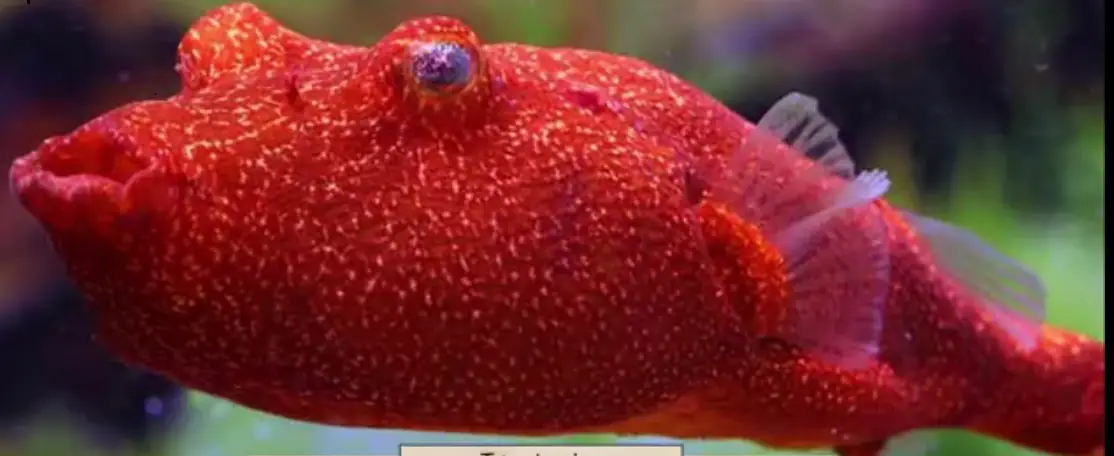
Feeding of freshwater puffers
Pufferfish are known as omnivorous animals, but they love eating a meat-based diet.
Pufferfish feeds on snails, shellfish, crustaceans, and other fishes in their natural habitat. If you keep them in an enclosure, you can feed them with live, dried, and frozen meat. You can also feed them with vegetable and plant-based food twice a week.
One of the things to put into consideration is their teeth, which grows during their whole life.
You will need to feed them with hard substrate animals like crustaceans, shellfish, or snails, which is going to help them control how their teeth grow. Your puffers will struggle to eat when their teeth grow too long, and you will need to clip them.
The feeding habits of your pufferfish are age and size-dependent.
- You will need to feed your 10-days old pufferfish daily. Although shellfish is not advisable for your baby pufferfish, you can start by feeding them with snails.
- You can feed juvenile fish that are between 2-4 inches every other day.
- Large species that are more than 4 inches can be fed two to three times a week. You should try to avoid overfeeding them because they can be persuasive by doing things to impress you so you can feed them.
Toxicity of freshwater puffers
Most of the pufferfish species are toxic, which makes them the most poisonous vertebrates in the world.
The internal organs like the liver and sometimes the skin usually contain tetrodotoxin, which is highly toxic and foul-tasting to fish.
The toxin is also more than 1200 times more toxic than cyanide if taken by humans.
The toxin is so potent that it can kill 30 adult humans, and there is no known antidote. The toxin of freshwater pufferfish according to their age, are listed below.
10-days pufferfish
10-days pufferfish look just as helpless as other baby fishes when you see it. Its parent usually abandons it, and some cannot even puff when threatened.
Baby pufferfish do not have enough toxins that they can also use to protect themselves.
One interesting thing about baby pufferfish is that they have toxins all over the surface of their body.
This is because of the mum puffer stores extra toxins on the place where they keep their eggs while some release toxins when she lays them.
This toxin will then stick to their body, and it helps to keep them from being eaten by predators.
Juvenile and adult pufferfish
Unlike larva puffers, juvenile and adult pufferfish have a higher concentration of toxins internally. It is internal because they get their poison from their diet.
The toxin can be found primarily in the liver and the ovaries, and there are also smaller amounts in the skin and intestines and even in trace amounts in the muscle.
The toxin makes pufferfish an unpleasant and lethal prey for predators. Pufferfish toxins do not have a lethal effect on large predators like sharks but can kill a human.
Tank size needed by puffers
You will need to decorate the freshwater puffer aquarium very well, and you should add caves and overhangs in their tank.
The caves will serve as shelter and hiding places for them.
You must provide amenities that will make your fish feel at home so that they do not die.
The tank size for each species will depend mainly on the type of species that you are planning to keep.
There are cases where larger species do not need much space because they are not usually active, while some small species need spaces where they can explore.
Ten days old puffers
This is the fry stage of puffers, and it is best to use a spotlessly clean tank and the one you can easily extract uneaten foods and fish wastes.
This is because fry can quickly get fungal infections from spoilt water.
You can keep them in a tank of 3-5 gallons of water so that their food and waste do not affect the water quality of the tank.
Juvenile and adult puffers
The tank size of juvenile and adult puffers will be based on the species that you want to keep in a tank.
Some of the recommended tank size for various freshwater pufferfish are listed below. Dwarf puffer, imitator puffer, and red-tailed dwarf puffer need 10 gallons of water.
Congo puffer, crested puffer, and South American puffer need 40-55 gallons of water.
Golden puffer needs 125 gallons of water while Mbu puffer needs 500 gallons of water.
These recommendations are suitable for fish only.
It is best to get a larger tank because of the amount of waste that they excrete.
Breeding
It is quite rare to breed pufferfish in captivity, and this is the reason why they are usually spawned in commercial tanks.
Different species of pufferfish need different water and tank requirements for successful breeding.
The tasking part when it comes to breeding for pufferfish is to find a compatible matching pair because of their aggressive nature.
After you get a matching pair, you will also find it hard to protect the fries after the eggs hatch because pufferfish are known to eat their fries.
The fries are also sensitive to changes in the conditions of water as they can quickly contact fungi infections.
You will then feed them with infusoria and freshly hatched Brine Shrimps till they reach the juvenile stage.
